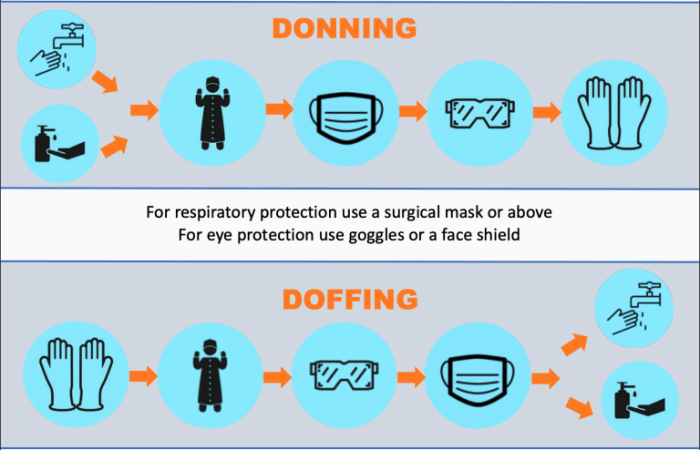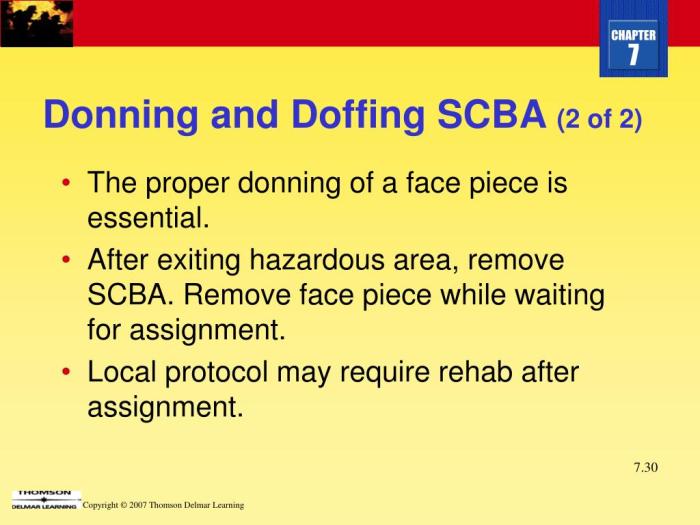After doffing scba always remember to – After doffing SCBA, it is imperative to follow specific safety protocols to mitigate risks and ensure personal well-being. This comprehensive guide explores the critical steps involved in doffing SCBA, emphasizing the importance of proper equipment maintenance, emergency preparedness, and adherence to regulations.
Understanding the potential hazards associated with improper doffing practices and the consequences of neglecting equipment maintenance is crucial for ensuring safety during and after SCBA use.
Personal Safety Precautions
Properly doffing SCBA (self-contained breathing apparatus) is critical for ensuring the safety of firefighters and other emergency responders. Failure to doff SCBA correctly can lead to serious injuries or even death.
Potential Hazards of Not Doffing SCBA Correctly
- Oxygen Deprivation:If the SCBA mask is not removed properly, the user may continue to breathe in the depleted oxygen supply, leading to oxygen deprivation and unconsciousness.
- Heat Exhaustion:The SCBA provides insulation, and if not removed promptly, it can cause the user to overheat, leading to heat exhaustion or heat stroke.
- Physical Injuries:The SCBA is heavy and bulky, and if not removed carefully, it can cause physical injuries, such as sprains or strains.
Examples of Incidents or Accidents
Numerous incidents and accidents have occurred due to improper doffing of SCBA. For example, in 2019, a firefighter in New York City collapsed and died after failing to remove his SCBA mask properly following a fire.
Equipment Maintenance: After Doffing Scba Always Remember To
Maintaining Self-Contained Breathing Apparatus (SCBA) equipment is paramount to ensure the safety and reliability of this critical life-saving gear. Proper maintenance extends the equipment’s lifespan, enhances its performance, and reduces the risk of malfunctions during emergencies.
Cleaning and Inspection
After each use, SCBA equipment should be thoroughly cleaned and inspected to remove contaminants, ensure proper function, and identify any potential issues. Cleaning involves washing the mask, harness, and regulator with a mild detergent solution, followed by rinsing and drying.
Inspection includes checking for leaks, cracks, corrosion, or damage to any components.
Consequences of Improper Maintenance
Neglecting proper SCBA equipment maintenance can have severe consequences. Unclean equipment may harbor bacteria or contaminants that pose health risks to the wearer. Damaged or malfunctioning components can lead to breathing difficulties, equipment failure, or even injury during emergencies. Regular maintenance is crucial to prevent such incidents and ensure the SCBA’s readiness when needed.
Procedures for Doffing SCBA

Doffing an SCBA is a critical safety procedure that must be performed correctly to ensure the safety of the wearer and those around them. The following step-by-step procedure Artikels the proper method for doffing an SCBA:
Step 1: Remove the Facepiece
Grasp the facepiece with both hands and pull it straight up and away from your face. Avoid touching the inside of the facepiece or the breathing tube.
Step 2: Remove the Harness, After doffing scba always remember to
Unbuckle the harness straps and lift the harness over your head. Be careful not to drop the harness or SCBA.
Step 3: Remove the Cylinder
Grasp the cylinder handle with one hand and the regulator with the other. Twist the cylinder counterclockwise to disconnect it from the regulator. Be careful not to drop the cylinder.
Step 4: Store the Equipment
Place the facepiece, harness, and cylinder in the designated storage area. Ensure that the equipment is properly secured and not damaged.
Importance of Following the Procedure Correctly
Following the proper doffing procedure is essential for several reasons:
- Prevents contamination: The SCBA is designed to protect the wearer from hazardous substances. Doffing the SCBA correctly ensures that the wearer does not come into contact with these substances.
- Prevents damage to equipment: The SCBA is a valuable piece of equipment. Doffing the SCBA correctly helps to prevent damage to the equipment, ensuring that it is available for use when needed.
- Maintains readiness: Doffing the SCBA quickly and efficiently allows the wearer to be ready to respond to emergencies.
Emergency Situations
In the event of an emergency, it is crucial to be prepared to doff your SCBA quickly and safely. There are several scenarios where rapid doffing of SCBA is necessary, including:
- A fire or explosion that requires immediate evacuation
- A hazardous material leak or spill that necessitates a quick escape
- A sudden loss of air supply or a malfunctioning SCBA
- A situation where the wearer is incapacitated or injured
To ensure personal safety while doffing SCBA in an emergency, it is imperative to:
Stay Calm and Assess the Situation
Remain composed and evaluate the emergency situation to determine the safest and most efficient course of action.
Prioritize Evacuation
If the situation demands immediate evacuation, focus on exiting the hazardous area as quickly as possible while following proper SCBA doffing procedures.
Signal for Assistance
Alert nearby personnel or emergency responders if you encounter any difficulties or require assistance during the doffing process.
Secure Your SCBA
Once you have exited the hazardous area, secure your SCBA in a designated location or pass it to a trained individual for proper disposal or maintenance.
Training and Education
Proper training and education are crucial for ensuring the safe and effective use of SCBAs. They equip individuals with the knowledge and skills necessary to operate, maintain, and doff SCBAs confidently and efficiently.
Training programs vary in duration and content, catering to different levels of experience and responsibilities. Basic training typically covers the fundamental principles of SCBA use, including donning, doffing, and emergency procedures.
Types of Training
- Basic Training:Introduces the basics of SCBA use, including donning, doffing, and emergency procedures.
- Advanced Training:Focuses on specialized techniques, such as confined space entry, working in hazardous environments, and team coordination.
- Refresher Training:Periodic training to reinforce knowledge and skills, ensuring proficiency in SCBA use and doffing.
Benefits of Ongoing Training
- Enhanced Safety:Refreshes knowledge and skills, reducing the risk of accidents and injuries.
- Improved Proficiency:Allows individuals to maintain their proficiency in SCBA use, ensuring they can respond effectively in emergency situations.
- Regulatory Compliance:Meets regulatory requirements for SCBA training and certification.
Record Keeping and Documentation

Maintaining accurate records of SCBA use and doffing is crucial for ensuring the safety and well-being of personnel and equipment. These records provide valuable insights into the operational history of SCBA, enabling informed decision-making and effective maintenance practices.
Types of Records
The following types of records should be kept:
- SCBA Inspection and Maintenance Records:Documenting regular inspections, repairs, and maintenance performed on SCBA units, including dates, tasks completed, and any issues identified.
- SCBA Use Records:Recording each time an SCBA unit is deployed, including the date, time, location, purpose of use, and the personnel involved.
- SCBA Doffing Records:Detailing the specific procedures followed during SCBA doffing, including the date, time, location, and the personnel involved.
- Training and Education Records:Documenting all training and education received by personnel on SCBA use and doffing, including the dates, topics covered, and the instructors involved.
Accessing and Using Records
These records should be easily accessible and readily available to authorized personnel. They can be used for various purposes, including:
- Safety Audits:Reviewing records to assess compliance with safety protocols and identify areas for improvement.
- Equipment Maintenance:Tracking maintenance history to determine when equipment is due for inspection or repair, ensuring optimal performance and reliability.
- Incident Investigation:Analyzing records to investigate incidents involving SCBA use or doffing, helping to identify root causes and develop preventive measures.
- Training and Development:Identifying training needs based on recorded incidents or areas where performance can be enhanced.
Regulations and Standards
SCBA use and doffing are subject to a variety of regulations and standards. These regulations and standards are designed to ensure the safety of SCBA users and to ensure that SCBAs are used and maintained properly.
It is important to comply with these regulations and standards because they help to protect the health and safety of SCBA users. Failure to comply with these regulations and standards can result in serious injuries or death.
Examples of Regulations and Standards
- OSHA 29 CFR 1910.134: This regulation establishes minimum requirements for the use of respiratory protection in the workplace.
- NFPA 1981: Standard on Open-Circuit Self-Contained Breathing Apparatus (SCBA) for Fire and Emergency Services: This standard establishes minimum requirements for the design, performance, and use of SCBAs.
- ANSI Z88.2: American National Standard for Personal Protective Equipment for Respiratory Protection: This standard establishes minimum requirements for the design, performance, and use of respiratory protection equipment.
Quick FAQs
Why is it important to doff SCBA properly?
Improper doffing can lead to exposure to hazardous substances, contamination of the SCBA, and potential injury.
What are the consequences of not maintaining SCBA equipment properly?
Neglecting equipment maintenance can compromise the integrity of the SCBA, potentially leading to equipment failure and increased risk to the user.
What should be included in a step-by-step procedure for doffing SCBA?
A step-by-step procedure should include instructions on removing the SCBA mask, disconnecting the regulator, purging the system, and properly storing the equipment.
What are some examples of emergency situations where quick doffing of SCBA is necessary?
Emergency situations may include fire, explosion, or chemical spills, where immediate removal of the SCBA is crucial for personal safety.